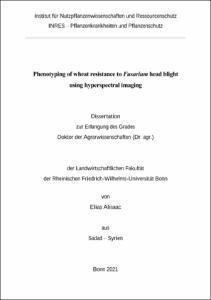Phenotyping of wheat resistance to Fusarium head blight using hyperspectral imaging

Phenotyping of wheat resistance to Fusarium head blight using hyperspectral imaging

| dc.contributor.advisor | Mahlein, Anne-Katrin | |
| dc.contributor.author | Alisaac, Elias | |
| dc.date.accessioned | 2021-02-10T09:01:12Z | |
| dc.date.available | 2021-02-10T09:01:12Z | |
| dc.date.issued | 10.02.2021 | |
| dc.identifier.uri | https://hdl.handle.net/20.500.11811/8915 | |
| dc.description.abstract | The integrated management of Fusarium head blight (FHB) on wheat depends on the implementation of agricultural practices, cultivation of resistant varieties, and fungicides application. Reducing yield losses and mycotoxin contamination caused by FHB on wheat requires fungicides application at a suitable time during the pathogenicity. This, in turn, needs accurate monitoring for disease incidence under field conditions to support the decision-making strategy to apply fungicides. In addition, the development of resistant variety demands screening of a large number of wheat entries for several years of the selection process. Furthermore, it needs mycotoxin quantification in wheat kernels of the advanced lines at the later stages of the breeding program. This research investigated the feasibility of optical sensors i.e. hyperspectral imaging (HSI), infrared thermography (IRT), and chlorophyll fluorescence imaging (CFI) to monitor FHB infection on wheat. In addition, it aimed at designing an automated model to rank wheat varieties according to their resistance to FHB based on HSI data. Moreover, it investigated the applicability of HSI to assess Fusarium infection and mycotoxin contamination in wheat kernels and flour. As well as the effect of infection timing on fungal development and mycotoxin contamination in wheat kernels.
The results of this research showed that optical sensors proved to be an effective tool to detect FHB infection on wheat spikelets and to follow the damage of Fusarium on wheat spikes. IRT was most sensitive to identify the early response of wheat to FHB infection followed by HSI and CFI. The combination of IRT-HSI led to superior accuracy during the pathogenicity. The results proved also the possibility for automatic ranking of wheat varieties according to their resistance to FHB based on the spectral vegetation indices (SVIs) derived from HSI. In addition, HSI showed feasibility to screen wheat kernels and flour for Fusarium infection and mycotoxin contamination. Combining these tools will accelerate the phenotyping and support the decision-making process in breeding programs by providing objective information about wheat resistance to FHB and mycotoxin contamination in wheat kernels and flour. This study demonstrated that Fusarium graminearum grows from the inoculation site downward. Moreover, it showed that F. graminearum can infect wheat spikes and cause deoxynivalenol (DON) contamination in wheat kernels not only at anthesis but also later stages of kernel development. In addition, it showed that infection timing plays a significant role in fungal growth and DON contamination. DON contamination was confined to the colonized kernels. Variety resistance and DON content have a close effect on DON detoxification in infected wheat kernels. The results of the current work showed that optical sensors, mainly IRT and HSI are promising tools to monitor FHB infection on wheat. These tools can be used to prevent quality and quantity losses caused by FHB in wheat yield. Besides, the results showed the feasibility of HSI to phenotype wheat resistance to FHB on the spike scale as well as to phenotype FHB infection and mycotoxin contamination on the kernel scale. This would be an effective advantage to accelerate the phenotyping process in the breeding programs. The results emphasized that the masked mycotoxin deoxynivalenol-3-glucoside should be legislated and monitored during the food and feed processing due to the high levels of this mycotoxin even with the late infection with FHB. | en |
| dc.language.iso | eng | |
| dc.rights | In Copyright | |
| dc.rights.uri | http://rightsstatements.org/vocab/InC/1.0/ | |
| dc.subject | Ährenfusariosen | |
| dc.subject | Mycotoxin | |
| dc.subject | Weizen | |
| dc.subject | Hyperspektrale Bildgebung | |
| dc.subject | Maschinelles Lernen | |
| dc.subject | Fusarium head blight | |
| dc.subject | Wheat | |
| dc.subject | Hyperspectral Imaging | |
| dc.subject | Machine learning | |
| dc.subject.ddc | 570 Biowissenschaften, Biologie | |
| dc.subject.ddc | 580 Pflanzen (Botanik) | |
| dc.subject.ddc | 630 Landwirtschaft, Veterinärmedizin | |
| dc.title | Phenotyping of wheat resistance to Fusarium head blight using hyperspectral imaging | |
| dc.type | Dissertation oder Habilitation | |
| dc.publisher.name | Universitäts- und Landesbibliothek Bonn | |
| dc.publisher.location | Bonn | |
| dc.rights.accessRights | openAccess | |
| dc.identifier.urn | https://nbn-resolving.org/urn:nbn:de:hbz:5-61056 | |
| ulbbn.pubtype | Erstveröffentlichung | |
| ulbbnediss.affiliation.name | Rheinische Friedrich-Wilhelms-Universität Bonn | |
| ulbbnediss.affiliation.location | Bonn | |
| ulbbnediss.thesis.level | Dissertation | |
| ulbbnediss.dissID | 6105 | |
| ulbbnediss.date.accepted | 18.12.2020 | |
| ulbbnediss.institute | Landwirtschaftliche Fakultät : Institut für Nutzpflanzenwissenschaften und Ressourcenschutz (INRES) | |
| ulbbnediss.fakultaet | Landwirtschaftliche Fakultät | |
| dc.contributor.coReferee | Léon, Jens |
Dateien zu dieser Ressource
Das Dokument erscheint in:
-
E-Dissertationen (1004)




